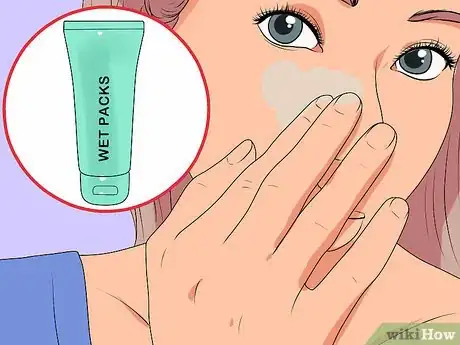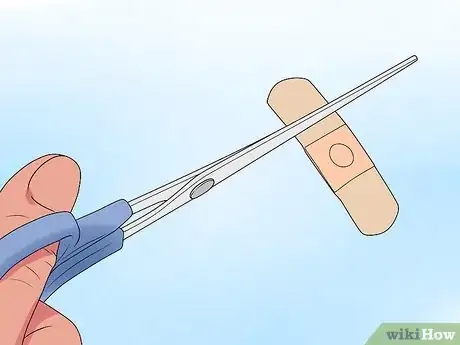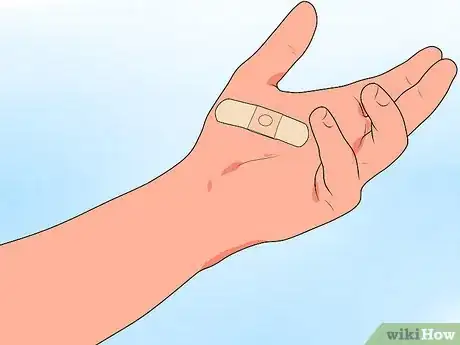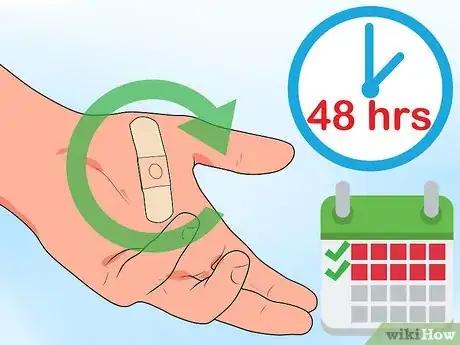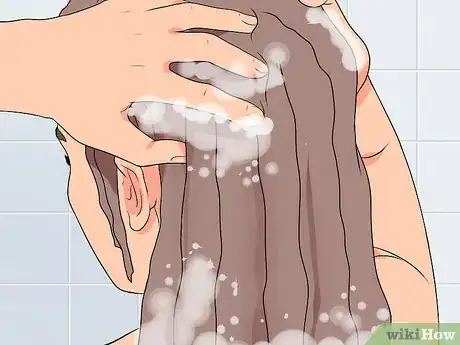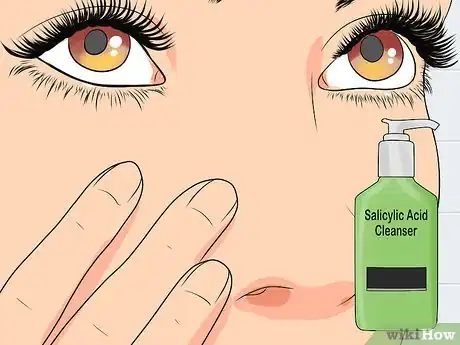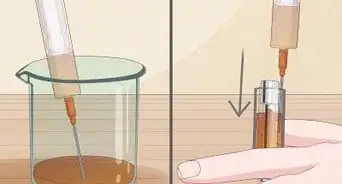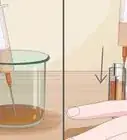This article was co-authored by Joanna Kula. Joanna Kula is a Licensed Esthetician, Owner and Founder of Skin Devotee Facial Studio in Philadelphia. With over 10 years of experience in skincare, Joanna specializes in transformative facial treatments to help clients achieve a lifetime of healthy, beautiful, and radiant skin. She is also a contributing author for the prestigious Les Nouvelles Esthetiques & Spa magazine and has been featured in a number of magazines including InStyle.
There are 7 references cited in this article, which can be found at the bottom of the page.
This article has been viewed 31,181 times.
Salicylic acid is an effective treatment for many common skin issues, including acne, dandruff, warts, psoriasis, and more. Once you have your salicylic acid, it’s important to apply it properly so you can reap all of its benefits. Determine what type of product you have, then apply it correctly so the acid can treat your skin.
Steps
Applying Salicylic Acid Cream, Gel, or Pads
-
1Clean your skin gently before you apply your salicylic acid. This removes the oils from your skin before you apply your cream, gel, or pad. Use a gentle cleanser that doesn’t irritate your skin.
- Dry your skin with a clean towel before you apply the salicylic acid.
- Pat your skin when you dry it, rather than rubbing it, so you don't stress it before application.
-
2Apply a thin layer if using a cream or a lotion. Use a cream or lotion with 3-6% salicylic acid.[1] Rub the product in gently until your skin absorbs it.[2]
- Don't worry if you see a thin film on top of your skin.
- Do this as often as you are instructed on the product or by your doctor. Most people do it first thing in the morning or right before bed at night.
Advertisement -
3Place wet packs on your skin if you are using a gel. After 5 minutes, remove them. Apply enough gel to cover the area and rub it in.
- Use a gel with .5-5% salicylic acid.[3]
- There may be a thin, invisible film that remains on top of your skin. Leave this and it will eventually soak in too.
-
4Wipe your pad over the affected areas. The pad will contain the proper salicylic acid dosage for you. Make sure that you cover the entire area.
- Don’t wipe the medication off after use. Instead, let it dry on your skin.
- Don't wash the area or get it wet until the medication is dry.
Applying Salicylic Acid Plaster
-
1Clean your skin before you use your salicylic acid plaster. Use a gentle soap or cleanser to remove any excess oils. Make sure you use a soap that will not irritate your skin. Dry your skin once you have cleaned it.
-
2Cut the plaster to fit the affected area. It will contain the proper dosage of salicylic acid. Make sure it covers the entire wart, corn, or callus that you are trying to remove.
- If your wort, corn, or callus is stubborn, soak the affected area for 5 minutes before you apply the plaster.
- Make sure your skin dries completely before you place the plaster.
-
3Place the pad on your skin over the wart, corn, or callus. Let it adhere fully, then cover it with a bandaid or a clean bandage.
-
4Repeat your treatment as needed. For corns and calluses, apply your salicylic acid every 48 hours for up to 14 days. For warts, apply it every 48 hours as needed.[4]
Using a Salicylic Acid Shampoo
-
1Rub the shampoo into your hair until it lathers. The lather indicates that you have used enough of the product for it to be effective. [5]
- Rubbing gets the shampoo down next to your scalp, where it can help your skin issue.
- Use your shampoo once or twice a week. If it hurts to rub your head, you may be using it too often.
-
2Allow the product to sit in your hair for 2-5 minutes. This gives it time to act on your skin so you can reap maximum benefits from the salicylic acid.[6]
-
3Wash it out thoroughly when the time is up. Give your hair an extra rinse. You don’t want salicylic acid to sit on your scalp all day.
-
4Reapply it for full effectiveness. Go through the whole process again. Wash your hair, let it sit, then rinse it out. This gives the salicylic acid more time to work on your skin.
Using a Salicylic Acid Cleanser
-
1Wash your face gently before using the salicylic acid cleanser. This removes all of the excess oils from your face so the acid can have maximum effectiveness. Choose a gentle soap that won’t irritate your skin.
-
2Rub a small amount of the salicylic acid cleanser into your skin. Use a cleanser with 3% salicylic acid or less.[7]
- Rub for at least 10-20 seconds, so the acid has time to penetrate your skin. Use gentle circular hand motions to rub it in.[8]
- Gentle rubbing allows the acid to contact your skin without risking irritation.
-
3Look for a lather. If it hasn’t worked up a lather, add a little more and rub again. Make sure you get at least 10-20 seconds of contact between your skin and the acid.
-
4Rinse your skin completely. You don’t want salicylic acid to sit on your skin all day. When you’re sure it’s all off, pat your skin dry with a clean towel.
Expert Q&A
-
QuestionIs salicylic acid good for skin?
 Joanna KulaJoanna Kula is a Licensed Esthetician, Owner and Founder of Skin Devotee Facial Studio in Philadelphia. With over 10 years of experience in skincare, Joanna specializes in transformative facial treatments to help clients achieve a lifetime of healthy, beautiful, and radiant skin. She is also a contributing author for the prestigious Les Nouvelles Esthetiques & Spa magazine and has been featured in a number of magazines including InStyle.
Joanna KulaJoanna Kula is a Licensed Esthetician, Owner and Founder of Skin Devotee Facial Studio in Philadelphia. With over 10 years of experience in skincare, Joanna specializes in transformative facial treatments to help clients achieve a lifetime of healthy, beautiful, and radiant skin. She is also a contributing author for the prestigious Les Nouvelles Esthetiques & Spa magazine and has been featured in a number of magazines including InStyle.
Licensed Esthetician It depends on your skin type! Salicylic acid is excellent for oily and acne-prone skin, or skin that is congested and has white or blackheads. The chemical works because it has anti-inflammatory properties that reduce redness and acne marks.
It depends on your skin type! Salicylic acid is excellent for oily and acne-prone skin, or skin that is congested and has white or blackheads. The chemical works because it has anti-inflammatory properties that reduce redness and acne marks.
Warnings
- Avoid ingesting salicylic acid or getting it in your eyes, ears, nose, or mouth. If you do, rinse it out as soon as possible.⧼thumbs_response⧽
- Salicylic acid can have negative side effects including skin irritation, swelling, difficulty breathing, and more.[10] If you experience anything unusual after using it, discontinue use and contact a doctor immediately.⧼thumbs_response⧽
- Never breathe in the fumes from these acid products as they can irritate your nasal passages. [11]⧼thumbs_response⧽
References
- ↑ https://www.drugs.com/dosage/salicylic-acid-topical.html
- ↑ https://www.webmd.com/drugs/2/drug-18-193/salicylic-acid-topical/salicylic-acid-for-acne-topical/details
- ↑ https://www.mayoclinic.org/drugs-supplements/salicylic-acid-topical-route/proper-use/drg-20066030
- ↑ https://www.mayoclinic.org/drugs-supplements/salicylic-acid-topical-route/proper-use/drg-20066030
- ↑ https://www.webmd.com/drugs/2/drug-18-825/salicylic-acid-topical/salicylic-acid-6-shampoo-topical/details
- ↑ https://www.drugs.com/dosage/salicylic-acid-sulfur-topical.html
- ↑ https://www.drugs.com/dosage/salicylic-acid-topical.html
- ↑ https://www.webmd.com/drugs/2/drug-18-193/salicylic-acid-topical/salicylic-acid-for-acne-topical/details
- ↑ https://www.mayoclinic.org/tests-procedures/allergy-tests/about/pac-20392895


